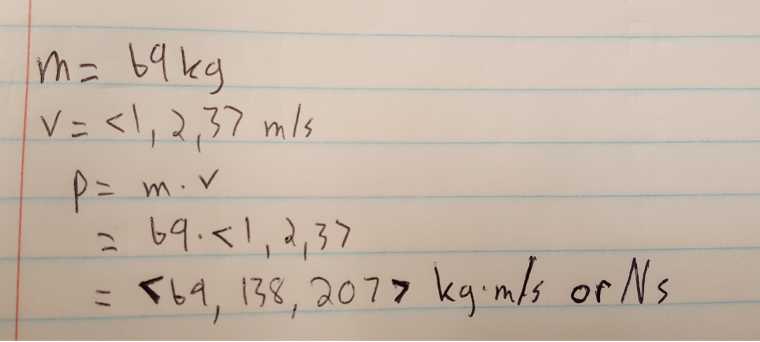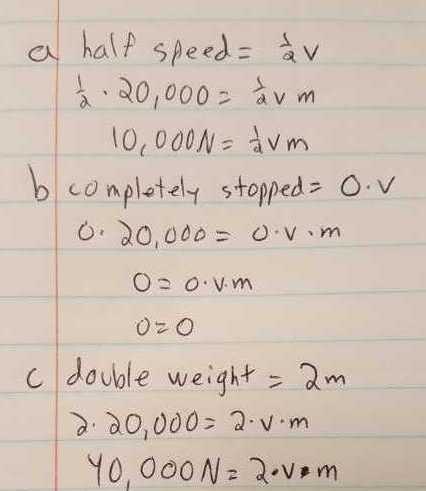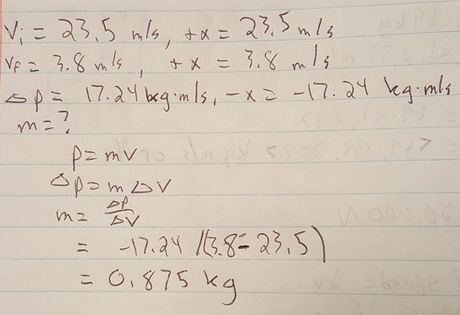Linear Momentum: Difference between revisions
| Line 21: | Line 21: | ||
Although the proof does not appear on this page, it can be shown that the total momentum of a system of particles is equal to the total mass of the system times the velocity of its [[center of mass]]: | Although the proof does not appear on this page, it can be shown that the total momentum of a system of particles is equal to the total mass of the system times the velocity of its [[center of mass]]: | ||
<math>\vec{p}_{system} = M_{total}\vec{v}_{center of mass}</math> | <math>\vec{p}_{system} = M_{total}\vec{v}_{center of mass}</math> | ||
Revision as of 10:56, 17 May 2019
This page defines the linear momentum of a particle or system.
The Main Idea
Linear momentum is a vector quantity describing an object's motion. It is defined as the product of an object's mass ([math]\displaystyle{ m }[/math]) and velocity ([math]\displaystyle{ \vec{v} }[/math]). Note that mass is a scalar while velocity is a vector, so an object's linear momentum is always in the same direction as its velocity. Linear momentum is represented by the letter [math]\displaystyle{ \vec{p} }[/math] and is often referred to as simply "momentum." The plural of momentum is momenta or momentums.
A Mathematical Model
Single Particles
The momentum of a particle is defined as follows:
[math]\displaystyle{ \vec{p} = m\vec{v} }[/math]
where [math]\displaystyle{ \vec{p} }[/math] is the particle's linear momentum, [math]\displaystyle{ m }[/math] is the particle's mass, and [math]\displaystyle{ \vec{v} }[/math] is the particle's velocity.
Multiple Particles
The total momentum of a system of particles is the vector sum of the momenta of the particles that comprise the system:
[math]\displaystyle{ \vec{p}_{system} = \sum_i \vec{p}_i }[/math]
Although the proof does not appear on this page, it can be shown that the total momentum of a system of particles is equal to the total mass of the system times the velocity of its center of mass:
[math]\displaystyle{ \vec{p}_{system} = M_{total}\vec{v}_{center of mass} }[/math]
In Relation to Newton's Second Law
When a force ([math]\displaystyle{ F }[/math]) is applied to a particle for a time interval Δt, the momentum of the particle changes by an amount
- [math]\displaystyle{ \Delta p = F \Delta t\,. }[/math]
This quantity is called impulse.
When differentiated, this represents Newton's Second Law. Put simply, rate of change of a particle's momentum is proportional to the force [math]\displaystyle{ F }[/math] acting on it over a certain interval of time. This is symbolized by
- [math]\displaystyle{ F = \frac{dp }{d t}. }[/math]
A Computational Model
In this code I have simulated what happens when a cart (visualized by the box) is acted upon by the force of a small gust of wind. Its initial velocity and mass is defined and you can clearly see it being affected by the wind. Due to the wind, its momentum changes because its velocity (both direction and speed) is affected by the wind. https://trinket.io/glowscript/ce43925647
Examples
Scenario
If you are standing at the bottom of a hill and faced with the option of stopping a runaway semi-truck or a runaway bicycle, you would probably choose to stop the bike because the semi truck has more momentum. Momentum simply means mass in motion. The semi truck has larger momentum because it is massive, but also has more speed.
Simple
Find the momentum of a ball that has a mass of 69kg and is moving at <1,2,3> m/s.
Middling
A car has 20,000 N of momentum. How would the momentum of the car change if: a) the car slowed to half of its speed? b) the car completely stopped? c) the car gained its original weight in luggage?
Difficult
You and your friends are watching NBA highlights at home and want to practice your physics. You notice at the beginning of a clip a basketball ball is rolling down the court at 23.5 m/s to the right. At the end, it is rolling at 3.8 m/s in the same direction. The commentator tells you that the change in its momentum is 17.24 kg m/s to the left. Curious at how many basketballs you can carry, you want to find the mass of the ball.
Connectedness
How is momentum used in Electrical Engineering?
Electrokinetic momentum is used in many devices to calculate the voltage necessary to change the current in an inductive circuit. This calculation is utilized within many electrical devices such as resistance grids.
History
Newton's 2nd Law
While Newton's 1st Law was not entirely his own, his 2nd and 3rd are.
Original Latin:
“Lex II: Mutationem motus proportionalem esse vi motrici impressae, et fieri secundum lineam rectam qua vis illa imprimitur.”
This was translated closely in Motte's 1729:
“Law II: The alteration of motion is ever proportional to the motive force impress'd; and is made in the direction of the right line in which that force is impress'd.”
Essentially:
The change of momentum of a body is proportional to the impulse impressed on the body, and happens along the straight line on which that impulse is impressed. In other words, F=ma.
See also
- http://www.physicsbook.gatech.edu/Velocity
- http://www.physicsbook.gatech.edu/Mass
- http://www.physicsbook.gatech.edu/Vectors
- http://www.physicsbook.gatech.edu/Newton%E2%80%99s_Second_Law_of_Motion
Further reading
Chabay, Sherwood. (2015). Matter and Interactions (4th ed., Vol. 1). Raleigh, North Carolina: Wiley.
References
- http://www.sparknotes.com/testprep/books/sat2/physics/chapter9section1.rhtml
- http://hyperphysics.phy-astr.gsu.edu/hbase/mom.html
- http://www.sparknotes.com/testprep/books/sat2/physics/chapter9section2.rhtml
- http://www.physicsclassroom.com/class/newtlaws/Lesson-3/Newton-s-Second-Law
- http://study.com/academy/lesson/linear-momentum-definition-equation-and-examples.html


